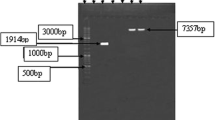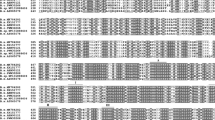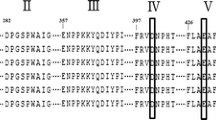Abstract
The bifunctional activities of α-amylase and pullulanase are found in the cloned recombinant amylopullulanase. It was encoded in a 2.9-kb DNA fragment that was amplified using polymerase chain reaction from the chromosomal DNA of Thermoanaerobacter ethanolicus 39E. An estimated 109-kDa recombinant protein was obtained from the cloned gene under the prokaryotic expression system. The optimum pH of the recombinant amylopullulanase was 6.0. The most stable pH for the α-amylase and pullulanase activity was 5.5 and 5.0, respectively. The optimum temperature for the α-amylase activity was 90°C, while its most stable temperature was 80°C. Regarding pullulanase activity, the optimum temperature and its most stable temperature were found to be 80 and 75°C, respectively. Pullulan was found to be the best substrate for the enzyme. The enzyme was activated and stabilized by the presence of Ca2+, whereas EDTA, N-bromosuccinimide, and α-cyclodextrin inhibited its bifunctional activities. A malto-2–4-oligosac-charide was the major product obtained from the enzymatic reaction on soluble starch, amylose, amylopectin, and glycogen. A single maltotriose product was found in the pullulan hydrolysis reaction using this recombinant amylopullulanase. Kinetic analysis of the enzyme indicated that the K m values of α-amylase and pullulanase were 1.38 and 3.79 mg/mL, respectively, while the V max values were 39 and 98 µmol/(min · mg of protein), respectively.
Similar content being viewed by others
References
Aunstrup, K. (1978), in Annual Reports on Fermentation Processes, vol. 2, Perlman, D., ed., Academic, New York, pp. 125–154.
Barfoed, H. C. (1976), Cereal Foods World 21, 588–593.
Forgarty, W. M. and Kelly, C. T. (1980), in Microbial Enzymes and Bioconversions, Rose, A. H., ed., Academic, New York, pp. 115–169.
Antranikian, G. (1990), FEMS Microbiol. Rev. 75, 201–218.
Zeikus, J. G., Lee, C., Lee, Y.-E., and Saha, B. C., Leatham, G. Y., and Himmel, M. E., eds. (1991), in Enzymes in Biomass Conversion, American Chemical Society, Washington, DC, pp. 36–51.
Mathupala, S. P. and Zeikus, J. G. (1993), Appl. Microbiol. Biotechnol. 39, 487–493.
Mathupala, S. P., Lowe, S. E., Podkovyrov, S. M., and Zeikus, J. G. (1993), J. Biol. Chem. 268, 16,332–16,344.
Marmur, J. (1961), J. Mol. Biol. 3, 208–218.
Ausubel, F. M., Brent, R., Kingston, R. E., Moore, D. D., Seidman, J. G., Smith, J. A., and Struhl, K. eds., (1993), Current Protocols in Molecular Biology, Greene Publishing & Wiley-Interscience, New York.
Sambrook, J., Fritsch, E. F., and Maniatis, T. (1989), Molecular Cloning: A Laboratory Manual, Cold Spring Harbor Laboratory Press, New York.
Sanger, F., Nicklen, S., and Coulson, A. R. (1977), Proc. Natl. Acad. Sci. USA 74, 5463–5467.
Studier, F. W., Rosenberg, A. H., Dunn, J. J., and Dubendorff, J. W. (1990), Methods Enzymol. 185, 60–89.
Bradford, M. M. (1976), Anal. Biochem. 72, 248–254.
Van Dyke, M. W., Sirito, M., and Sawdogo, M. (1992), Gene 111, 99–104.
Laemmli, U. K. (1970), Nature 227, 680–685.
Raha, M., Kawagishi, I., Muller, V., Kihara, M., and Macnab, R. M. (1992), J. Bacteriol. 174, 6644–6652.
Melasniemi, H., Paloheimo, M., and Hemio, L. (1990), J. Gen. Microbiol. 136, 1447–1454.
Sata, H., Umeda, M., Kim, C.-H., Taniguchi, H., and Maruyama, Y. (1989), Biochem. Biophys. Acta 991, 388–394.
Author information
Authors and Affiliations
Corresponding author
Rights and permissions
About this article
Cite this article
Lin, FP., Leu, KL. Cloning, expression, and characterization of thermostable region of amylopullulanase gene from Thermoanaerobacter ethanolicus 39E. Appl Biochem Biotechnol 97, 33–44 (2002). https://doi.org/10.1385/ABAB:97:1:33
Received:
Revised:
Accepted:
Issue Date:
DOI: https://doi.org/10.1385/ABAB:97:1:33




